At the start of each year, Disneyland’s Haunted Mansion shuts down for a short while to remove its Nightmare Before Christmas inspired overlay and revert back to the boundless realms of the supernatural. To help tide you over, let’s get spooky…
In my book Boundless Realm, I begin with an overview of the whole of American horror – from superstition through to Washington Irving and Edgar Allan Poe on to horror movies and Walt Disney. I go through all of that darn trouble because, well… it’s my book and I like it. But also because I want to situate the Haunted Mansion in a context of ghost folklore, drawing an explicit connection to another era of spook entertainment – the kind that could have influenced a young Marc Davis or Claude Coats in the 1920s.

It’s a terrific chapter, one of my favorites in the book. But it’s not the only way I could have positioned the Haunted Mansion in a cultural context, and I’m thinking it may be fun to try taking a look at it from another angle. Maybe an angle that will resonate more with readers who, you know, don’t spend a lot of time watching old horror movies and reading Victorian ghost stories.
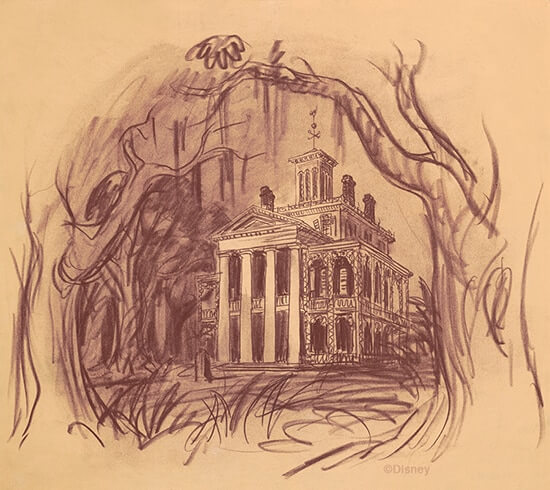
So lets you and I walk the wrong way down the Speedramp at the end of the ride, slip into a passing Doombuggy thanks to the help of a sympathetic maid or butler, and ride our little plastic pod back to where this all began.
In a moment or two, we’ve popped out of the darkness at the top of the staircase and we’re looking down on the flickering lights of the load area. We’re going to go around again, back to the start, to look at the whole thing with a new perspective…
The 1950s was a bleak and nervous decade for the “Greatest Generation.” The post-war clouds had not really dispersed and seemed to be growing ever more ominous. Many fathers never really recovered from the experience and drifted away from family life; divorce rates were through the roof. Those who did return to civillian life returned to an even more aggressive workplace; everyone seemed to be trying to claw their way to the top of the heap.

The GI bill and a boom in cheap construction made it suddenly possible for many families to buy a car and move out of the polluted city to the new suburbs; the “country living” so venerated by the social scientists through the 30s and 40s turned out to be a bit of a bore once they actually arrived. Kids couldn’t play in the street— that was for cars. They couldn’t play on the lawn either— it had to stay neat. Adults reached out to each other through cocktail parties, bowling leagues, or sometimes just the neighborhood bar. In response, the kids got a little weird.

The early 50s saw a boom in science fiction and monster movies such as It Came From Outer Space; by 1955, the year Disneyland opened, the fad turned into a tidal wave. Godzilla, Them!, The Thing From Another World, and the Creature From the Black Lagoon burned up the box office and much of the audience going to see these movies were suburban youngsters with working parents and a lot of free time on their hands. After shivering through cheap creature features like Gorilla at Large, many kids came home and began making monster masks and playing with toy ray guns. Parents and watchdog groups looked on with the same sense of amusement and concern that meets any youth fad. Hollywood studios planned even more horror pictures; best to make hay while the sun was shining.
Then, in 1957, television turned the fad up to eleven.
Universal Studios had sold licensing rights to a huge chunk of their back catalog of horror films to Columbia’s Screen Gems; Columbia tacked on a few of their own B pictures and sold the whole thing to television affiliates as “Shock Theater”. Shock Theater was a monumental success. In some markets viewership merely increased 30 percent; in others it was more like 1000 percent. Stations and advertisers had a field day; within a few years, larger stations began hiring local actors to “host” the creature features in makeup with sardonic banter. New York had Zacherley, the Cool Ghoul; Fort Worth had Gorgon; Portland had The Tarantula Ghoul; Cleveland was bemused by Ghoulardi. And that’s just a few of them!
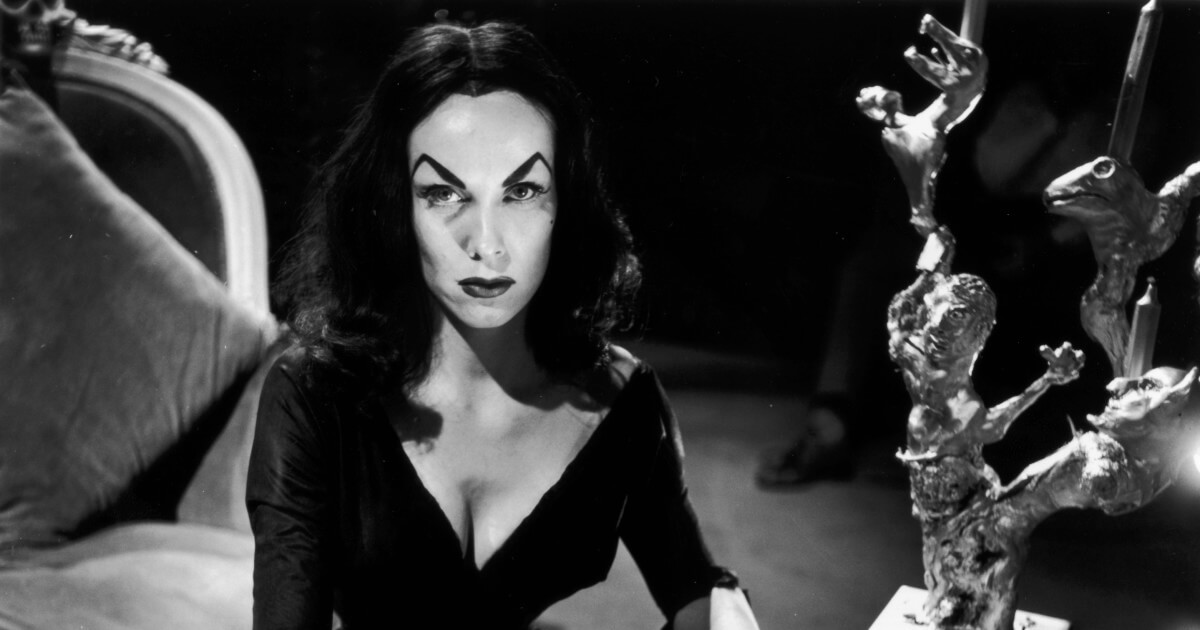
But at this point the whole market was still being driven by novelty; everyone expected the horror fad to play itself out in a few years, just as it had in the early 30s and early 40s. Then, as now, where there is a quick buck to be made, the people willing to make that buck will start lining up. By 1958, there was a whole army of them.
One of these quick money men was Roger Corman, who slapped together $12,000 to make Monster From the Ocean Floor. It did well enough that a few more modestly budgeted exploitation pictures followed, including something called The Fast and the Furious, a title that still gets butts into seats. Corman began selling his tiny pictures to an outfit called American International Pictures; he liked them because they gave him money up front. Within a few years, thanks to the immortal I Was A Teenage Werewolf and other movies just well made enough to not bore teenagers, Corman and AIP were producing genre films as good as any made by a major studio.
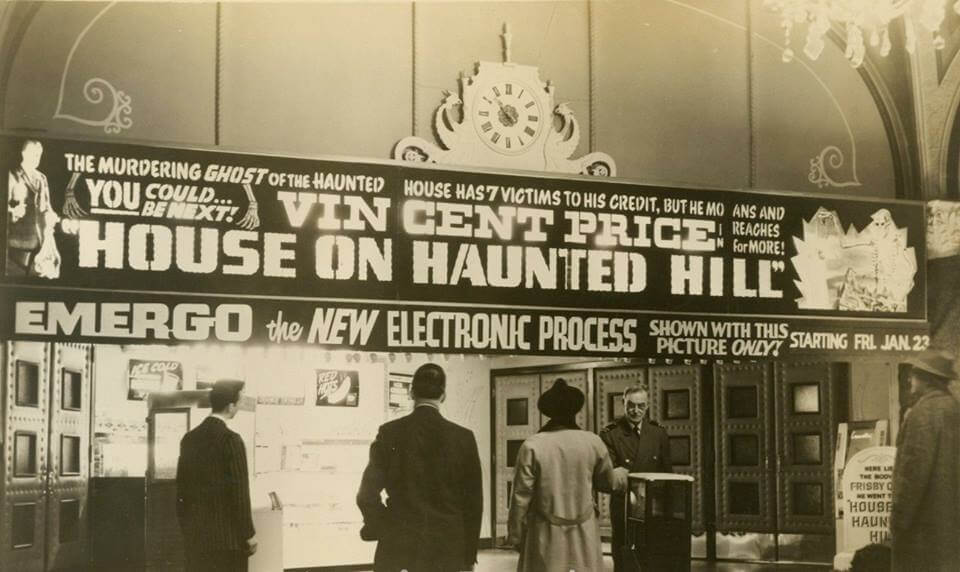
Another one of the sharp pencil boys was William Castle, lately of the Columbia B unit, who had been making good and cheap thrillers through the 1940s. Castle mortgaged his house and made a lurid little beat-the-clock suspense picture called Macabre. The picture didn’t matter as much as the publicity, where he convinced Lloyd’s of London to ensure everyone watching the picture against Death by Fright. The movie was good, but the publicity was better, and Macabre turned into a money maker. Castle’s subsequent exploitation pictures are the stuff of legend; House on Haunted Hill floated a plastic skeleton out over the audience for kids to throw popcorn boxes at. The Tingler featured seats that buzzed, a plant in the audience who fainted and was carried out on a stretcher, and a bathtub full of red blood inserted into a black and white film. Kids ate it up.
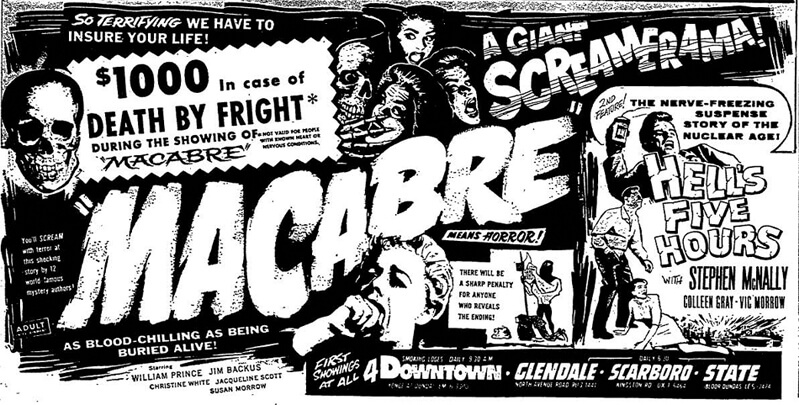
These hot summer matinees of the Eisenhower years were vividly described by historian Tim Lucas:
“American kids of the early 1960s went to horror movies because they gave them opportunities to scream, to squeal. And if one kid screamed, they all joined in. It was a fun release – it didn’t have anything to do with horror, really. To be the kid who set off a theater-wide scream was like holding the keys to a kingdom… or lighting the wick of a bomb.”
1958 was also the year that publisher James Warren and fantastic film fan Forrest J Ackerman unleashed Famous Monster of Filmland. Originally intended to be a gag one-off publication treating classic movie monsters as glamourous film stars, the issue turned out to be a sensation among monster-mad kiddos and the magazine ran until 1983. Up until 1958, horror movies were an on-again, off-again thing, often treated with little respect and care. Starting with the 1950s sci-fi and horror boom, the genre was here to stay. Young genre aficionados spread across the country networked through the pages of Famous Monsters. They called themselves the monster kids, and you may have heard of a few of them: Steven Spielberg, John Landis, Stephen King, John Carpenter, Tim Burton, Joe Dante, and Rick Baker.
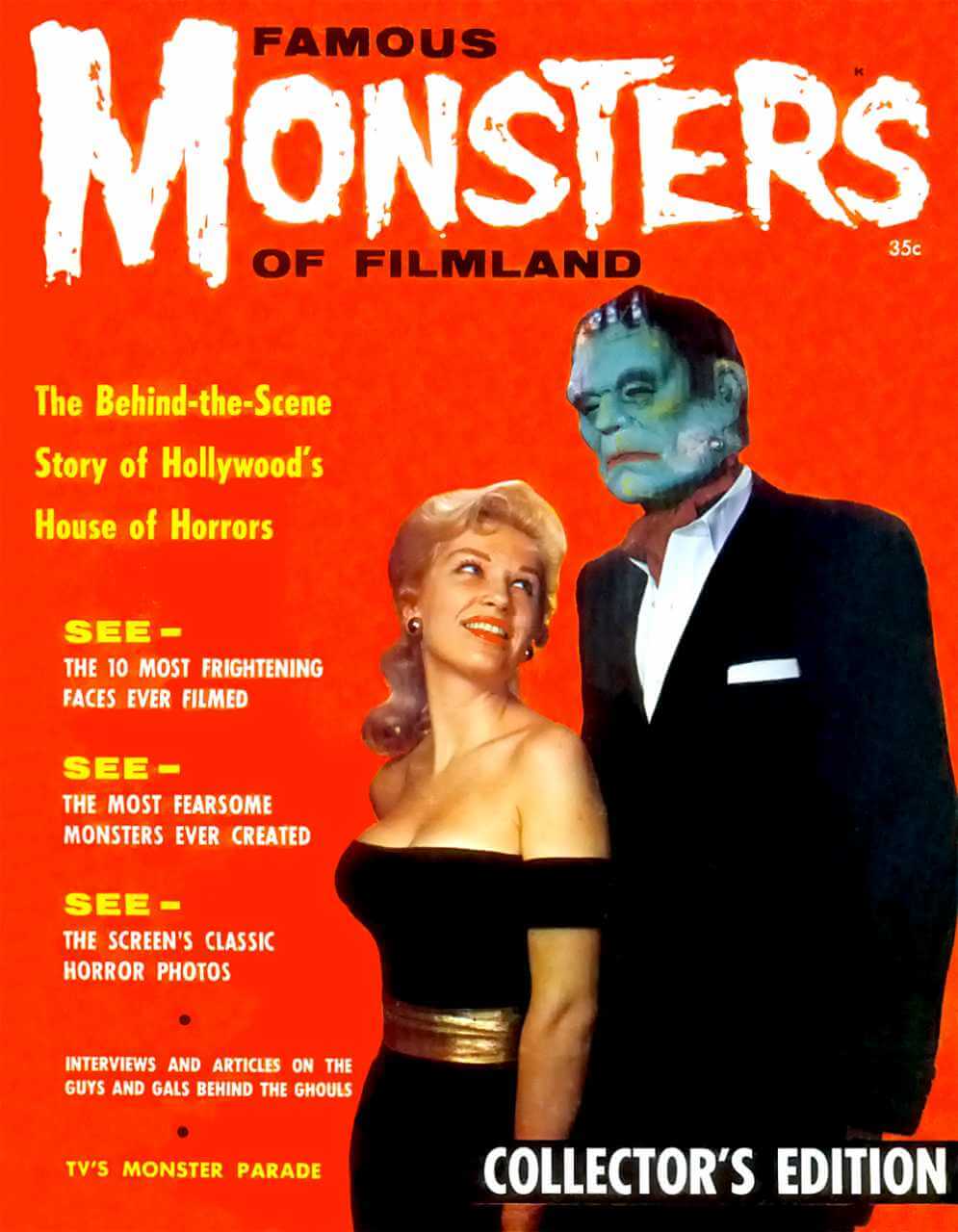
It was at this juncture that Alfred Hitchcock unleashed his monster hit Psycho, demonstrating that there was a market for horror thrills beyond the kiddie crowd. Pointedly, Hitch shot the film in the Corman / Castle style, with a low budget in black and white and with just one major star. It helps that the film is a genuine classic, but in its day the film was promoted with just as many goofy stunts as The House on Haunted Hill, with cardboard standees of Hitch outside theaters admonishing audiences that they must see Psycho from the start of the film – no late arrivals! Hitch himself hosted an amusing ten minute trailer, teasing each of the film’s major shocks. Adults ate it up just as readily as the kids did.

The Sixties dawned with no signs of the fad slowing down. Roger Corman and Vincent Price were making a lavish series of Edgar Allan Poe thrillers for AIP; Hollywood maverick Robert Aldrich directed Whatever Happened to Baby Jane? and Hush Hush Sweet Charlotte. Bobby Pickett’s The Monster Mash immortalized the link between classic horror and the pre-Beatles youth culture of the early 60s. Aurora plastics began manufacturing their legendary glow-in-the-dark Monster model kits in 1962; advertising blared: “Frightfully easy to assemble! Build your own Chamber of Horrors!”
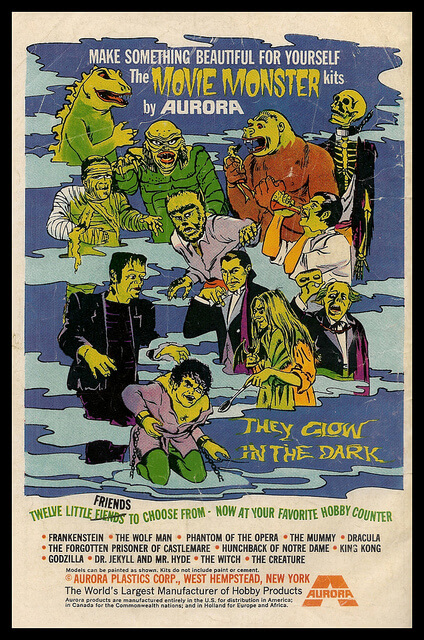
In 1964, the nearest thing to middle class cultural legitimacy was bestowed upon the creepies and crawlies from last Halloween: two primetime, mainstream sitcoms. The Munsters and The Addams Family took two very different approaches to the same basic joke, but the result was the same: monsters were family, maybe even respectable.
They were just like us.


The Haunted Mansion very much belongs to this cultural moment, the years when horror movies stopped being cheap juvenile entertainment but were also not yet so deadly serious as they would shortly become. It actually opened just slightly after the peak of the era, but it synthesizes the whole of the 50s and 60s monster fad into an unreplicable whole. The aesthetics of the attraction owe more to a lost era of Gothic splendor than anything on television screens in 1965, but you’ll notice that the Ghost Host cracks just as many jokes as any host of Shock Theater ever would. His narration turns something played fairly straight into a light send-up; the ghosts may take themselves seriously, but we don’t have to – not with atrocious puns in our ears like “wall to wall creeps and hot and cold running chills”.

The Ghost Host is even given special privilege to make modern puns; he references the 60s fad for beach dune buggies and calls the huge party thrown by the revenant ghouls a “swinging wake” in the pure 1969 sense. When we get to the graveyard jamboree what we see are seventeenth-century musicians, medieval flutists, a Victorian tea party, and a Wagnerian opera power couple. But what we hear is a late 60s beach party: funky bass line, rhythm guitar, and an organ played in a pseudo-rock style. This connection to the cultural moment is made even clearer by the 1972 release of glow-in-the-dark model kits based on the ghouls in the attraction; monster kids of the 70s could place “The Grave Robber” alongside their Aurora plastic Lon Chaney Wolf Man. Disney knew who their market was.
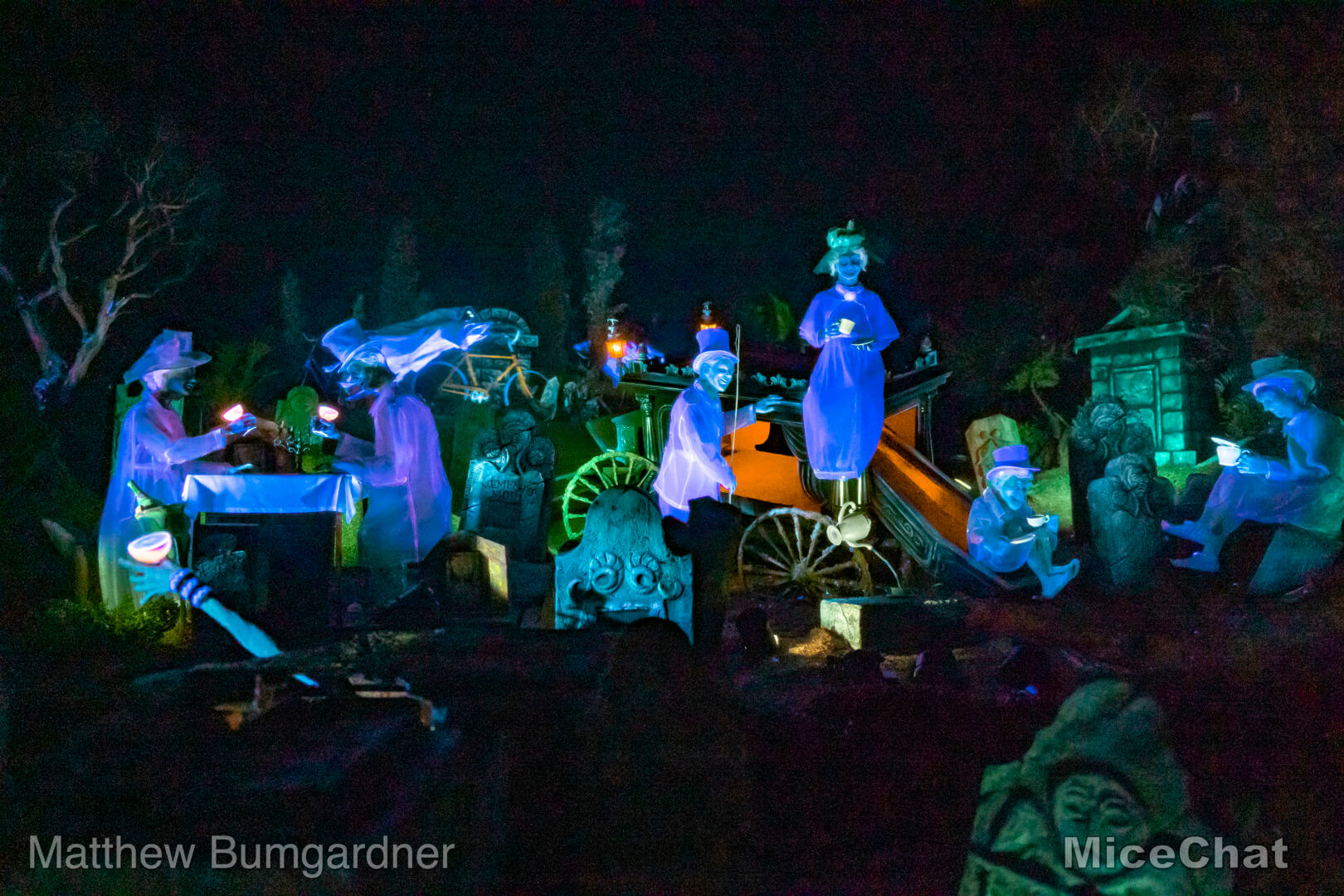
The Haunted Mansion opened at Disneyland to record crowds; according to Disney, in the month following its debut attendance records were set for a single day (82,516 on August 16), a single week (455,757 for the week ending August 23), and a single month (1,582,199 in August). Attendance continued to build until mid-September and the single-day record apparently went unchallenged for over 15 years. Disney officially tends to treat this as a phenomenon related to such factors as the long-delayed opening, but the generation of horror buffs congregated around Southern California couldn’t have hurt.
If that doesn’t convince you that this sort of material was in the air, consider this: the very first episode of Scooby Doo, Where Are You? premiered a mere month after the Mansion opened, in September 1969.

It’s hard to say what people on the ground thought of the Haunted Mansion at the time. Opinions on theme parks were not so rigorously recorded for the public record as they are now. Most newspapers were content to reprint publicity squibs prepared by WED for the occasion. Jack Smith, who wrote up the most significant early review of the attraction for the Los Angeles Times, took the opportunity to crack jokes about “Aunt Ethel” and Scrabble. He sniffed that the ten-year development cycle seemed mysterious. This is the modern equivalent of using a review of whatever’s new in Disney California Adventure to complain about dabbing.
The Walt Disney World version of The Haunted Mansion opened in Magic Kingdom in Florida in 1971 and perhaps without the advantage of a Pirates of the Caribbean or an Adventure Through Inner Space to compare it to. Though, it immediately became the hit attraction of the park. By December 1973 Newspapers were still calling it out as the attraction to beat during President Nixon’s trip to the resort. And so most of the earliest print reviews of the attraction do come from Florida, often from bewildered journalists who struggled to express the full measure of the experience.
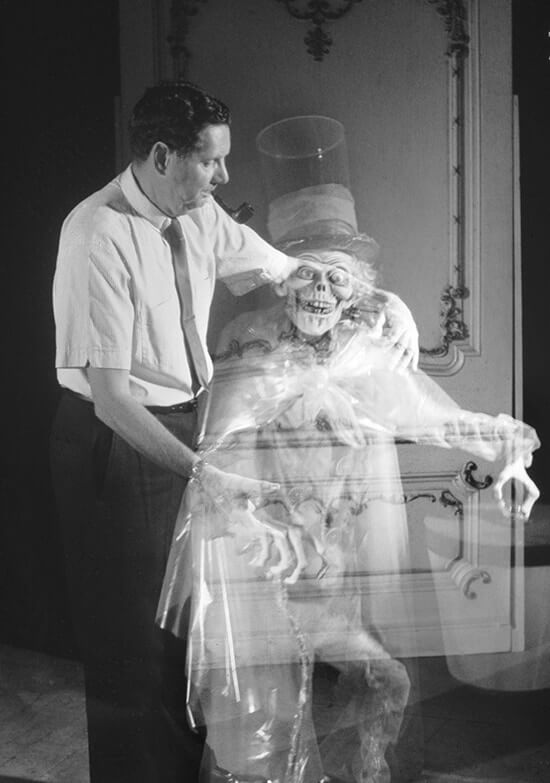
Travel Magazine wrote in March 1972 as part of a review of the entire Walt Disney World complex, “The Haunted Mansion is a pop-eyed puzzler that sent us through it twice. Its illusions are so startling that we won’t even hint at their amazing impact.”
But Edward L. Prizer of Orlandoland Magazine was moved to wax poetic: “The Haunted Mansion is the craziest thing I’ve ever seen. I’ve only been through once and can’t render final judgment. But I think first of all it must be regarded as a thing of beauty evoking the images of Edgar Allan Poe with a whimsical twist. This is the kind of ambiguity that lifts imagery to the level of art.”
Some people are just always ahead of the curve.
In 1967, Motion Picture Association of America president Jack Valenti formally retired the motion picture code (in place since 1934) and created a ratings system. Almost immediately, filmmakers began to create films that presented material unimaginable onscreen just a decade before, and audiences flocked to movies presenting illict thrills. Some of these films were legitimate artistic and thoughtful examinations of themes previously outlawed on screen, but…. you know, a lot of them weren’t.
Horror movies had, up until this time, been mostly the domain of cheap production outfits like AIP and some feisty independents. There were exceptions, like Warner-Seven Arts’ The Haunting, but they were scarce. That began to change in the late 60s as more and more major studios became comfortable releasing films of fantastical content and the audience’s appetite for boundary-pushing thrills kicked into high gear. Seat-tingler William Castle released Rosemary’s Baby, a prestige picture with respected actors about a woman who may, or may not, be giving birth to a demon. It went over well, because by 1971 major studio terrors had exploded in number: See No Evil, Omega Man, Play Misty For Me, Let’s Scare Jessica to Death, The Devils, and Willard arrived onscreen in one screen season.
But none of that could compare to the frenzy unleashed by Warner Brothers’ The Exorcist in 1973, a $10 million shocker given wide release and an R rating. Lines for the movie literally stretched around city blocks in New York – it’s the first true modern horror movie in the sense of a film that it’s a relentless assualt on the audience. Everybody saw The Exorcist, sometimes multiple times; adjusted for inflation it’s still one of the most profitable horror films ever made.
But the story of The Exorcist is more than one of wild success. If from 1950 to 1958 horror content was a fad to be struck while the iron was hot… If from 1958 to 1973 it was a regular (if disreputable) part of the film-going diet… Then 1973 and The Exorcist is when terror films became a national institution, baptized in tens of thousands of gallons of pea soup.
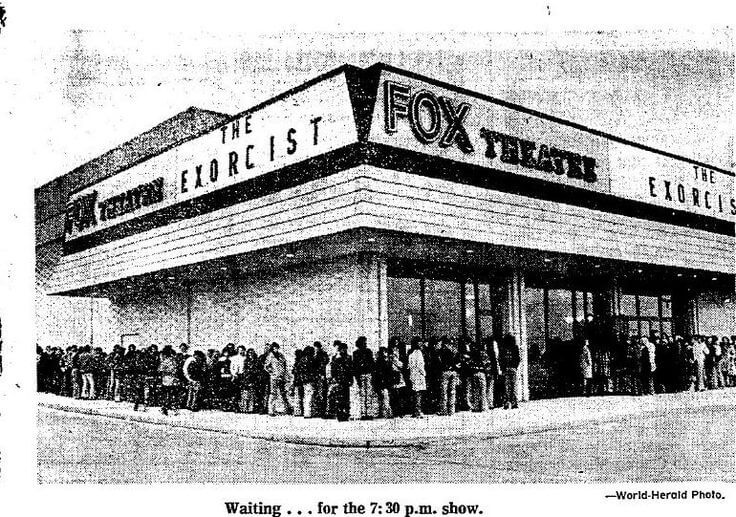
Horror was ringing through the hinterlands. People began to take decorating to the next level, sometimes beyond that. Unlike Christmas, Halloween has always been at its heart a DIY holiday, and plastic skeletons and plywood coffins knocked together by some suburban Dad in the garage began to become frequent sights. Beware the Dark Realm in Santa Clarita began operating in 1971, a walk-through haunted castle with scares and atmosphere aplenty. Local Kiwanis, 4H, and Lions Clubs began offering horror mazes as a regular feature of seasonal fundraising.

If the Haunted Mansion pushed Disneyland into a new level of popularity, then Knott’s Berry Farm up the street was having some trouble bringing in the crowds. The Gypsy Camp expansion had opened in summer 1971 to a resounding thud of interest, opening the family-run attraction to offers for new ideas. The new idea that stuck presented itself in 1973, having emerged from the depths of late-night television horror fandom.
Sinister Seymour, aka actor Larry Vincent, was a horror host with a difference. While bantering and less-than-serious horror movie hosts were nothing new, Vincent absolutely mocked the films being shown, sometimes appearing in cutaways or windows at the bottom of the screen with his sarcastic remarks during the movie. In this sense, Sinister Seymour was a pioneer in a field later occupied by Mystery Science Theater 3000, Joe Bob Briggs, and The Angry Video Game Nerd. Baby boomers were the first generation to grow up marinated in mass culture, and Vincent’s sarcastic remarks made him a local hero in Los Angeles.
After appearing several times at Magic Mountain in Valencia, Vincent brought an expanded version of his show to Knott’s Berry Farm where he would mock a film live in person in the Farm’s John Wayne Theater. To mark the occasion, Knott’s threw a Halloween party complete with actors in costumes, special decorations, and a self-guided tour through a “Monster Maze”. They called it Knott’s Halloween Haunt, inventing all at once the seasonal event, scare actors, and even the name of any highly decorated self-guided scary experience… a “haunt”.
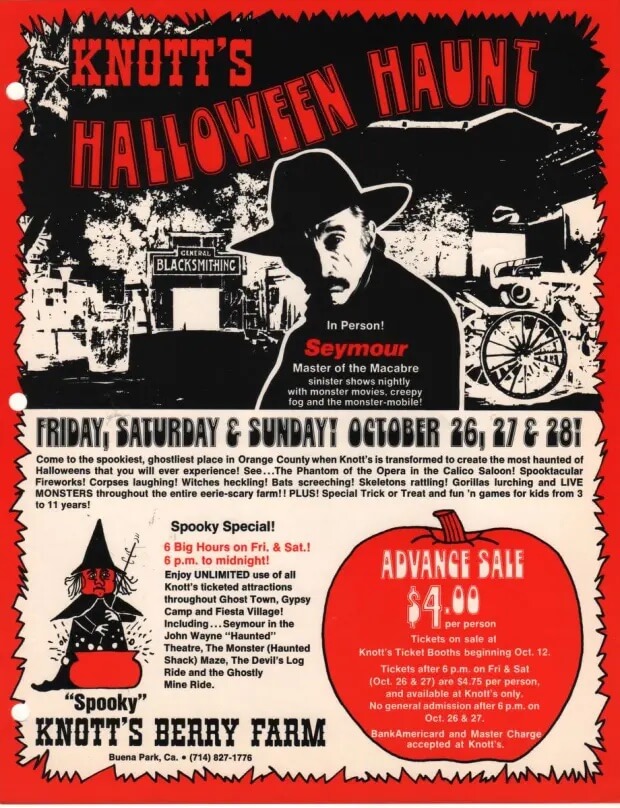
The Southern California-specific nature of the birth of the modern haunted attraction is an interesting point to consider. Some of it certainly has to do with Hollywood and Disneyland being nearby, yes. But LA was doing theming 30 years before Disneyland was even a thing, from mission revival architecture to giant donuts to space-age diners. It’s a local tradition. I think it’s very likely that Knotts wouldn’t even have thought to try a horror-themed event were it not for Disneyland’s exemplary ghost house down the street, an attraction full of elaborate details and illusions which also begins as an on-foot experience. Most who build home haunts still cite the Haunted Mansion as a key influence 50 years on, so the fact that haunted walkthroughs started sprouting like mushrooms just a few years after it opens cannot be a coincidence.
Today, haunted attractions are an economy that produces billions of dollars annually. It was the specific intersection of Disneyland, a generation raised on horror movies, monster kids, and modernity that gave us Halloween as we know it today. But there was one thing missing.
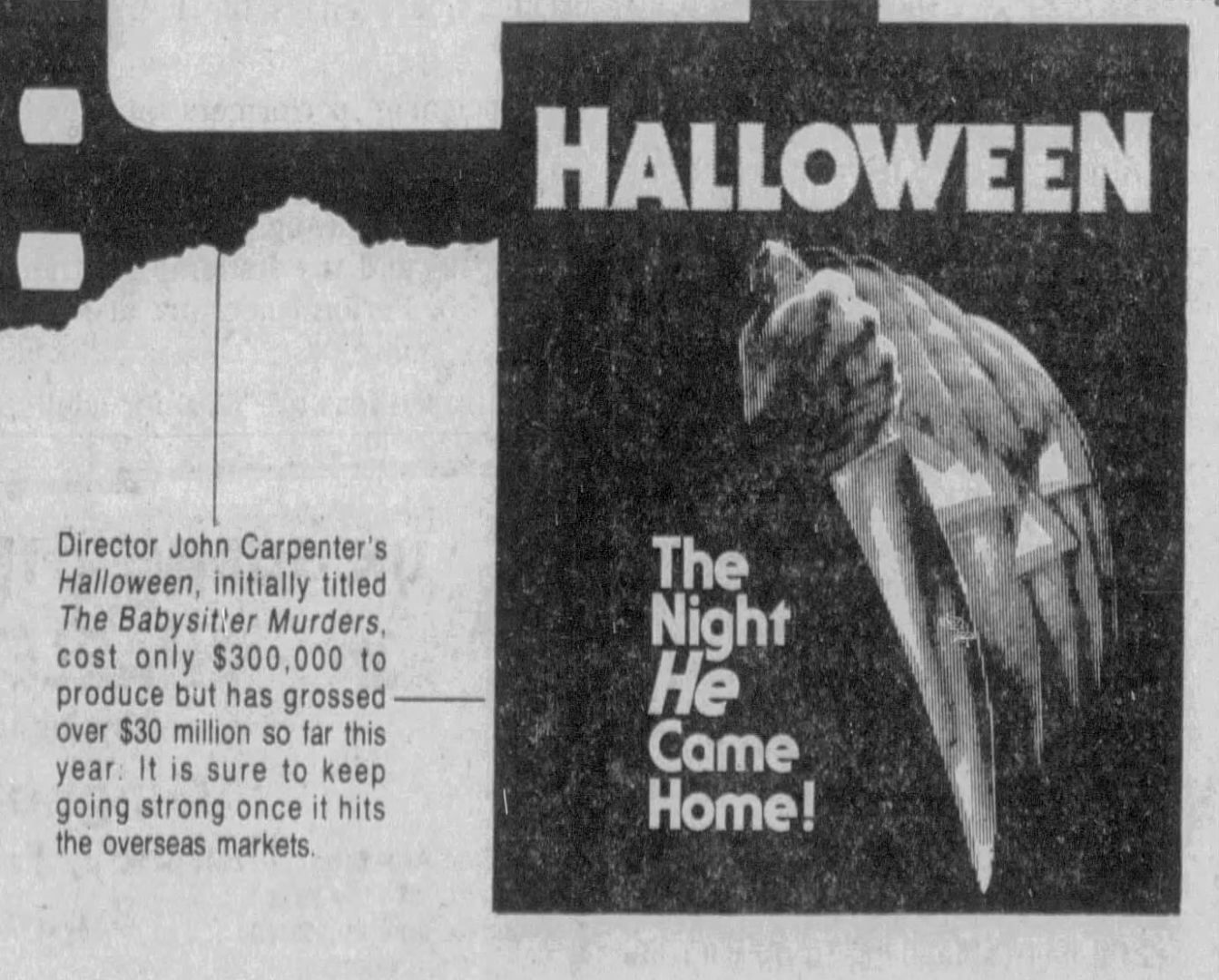
In 1978, film producer Irwin Yablans and financier Moustapha Akkad approached a young director named John Carpenter to produce a film about a serial killer stalking babysitters. They, like everyone else, had seen the insane success of The Exorcist and wanted their own slice of the market. Yablans apparently suggested setting the film on Halloween night, and The Babysitter Murders transformed into Halloween, forever enshrining the holiday in the pantheon of the film genre that helped create it. Many small towns and cities spent most of the 1970s discouraging Trick or Treating due to hysteria over urban legends of razors in apples and poisoned candies, and I’d love to know to what extent the success of Halloween supercharged the holiday’s observance.
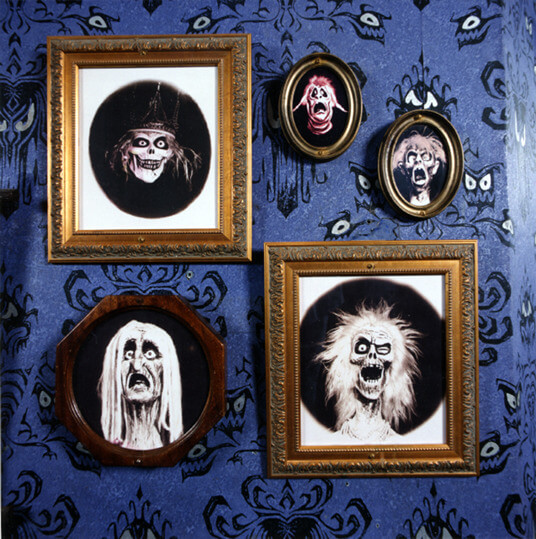
Okay, hold up. I’m going to clip this story right here – from 1950 to 1980, roughly thirty years time. From the creation of Disneyland to the explosion of slasher flicks – I think I can trust you to know your popular horror history from the advent of Michael Myers forward. But remember that I started with postwar doldrums and suburbs for a reason, because if we pull back out of our genre history lesson and look at the culture as a whole, we can notice that this same era is when Americans really began to practice Halloween.
Yes, yes, I can hear you at the back, we all know that the term derives from All Hallow Mass, and Celtic new year, and Samhain, and blah blah blah – we’ve all seen the specials on History Channel.
But going back to that stuff is missing the point, because when you and I say the word Halloween what we’re really saying is: candy, and decorations, and haunted houses, and parties, and little kids dressed up like Dracula. And all of that, all of the stuff which is the reason you love Halloween, was born between 1950 and 1980.
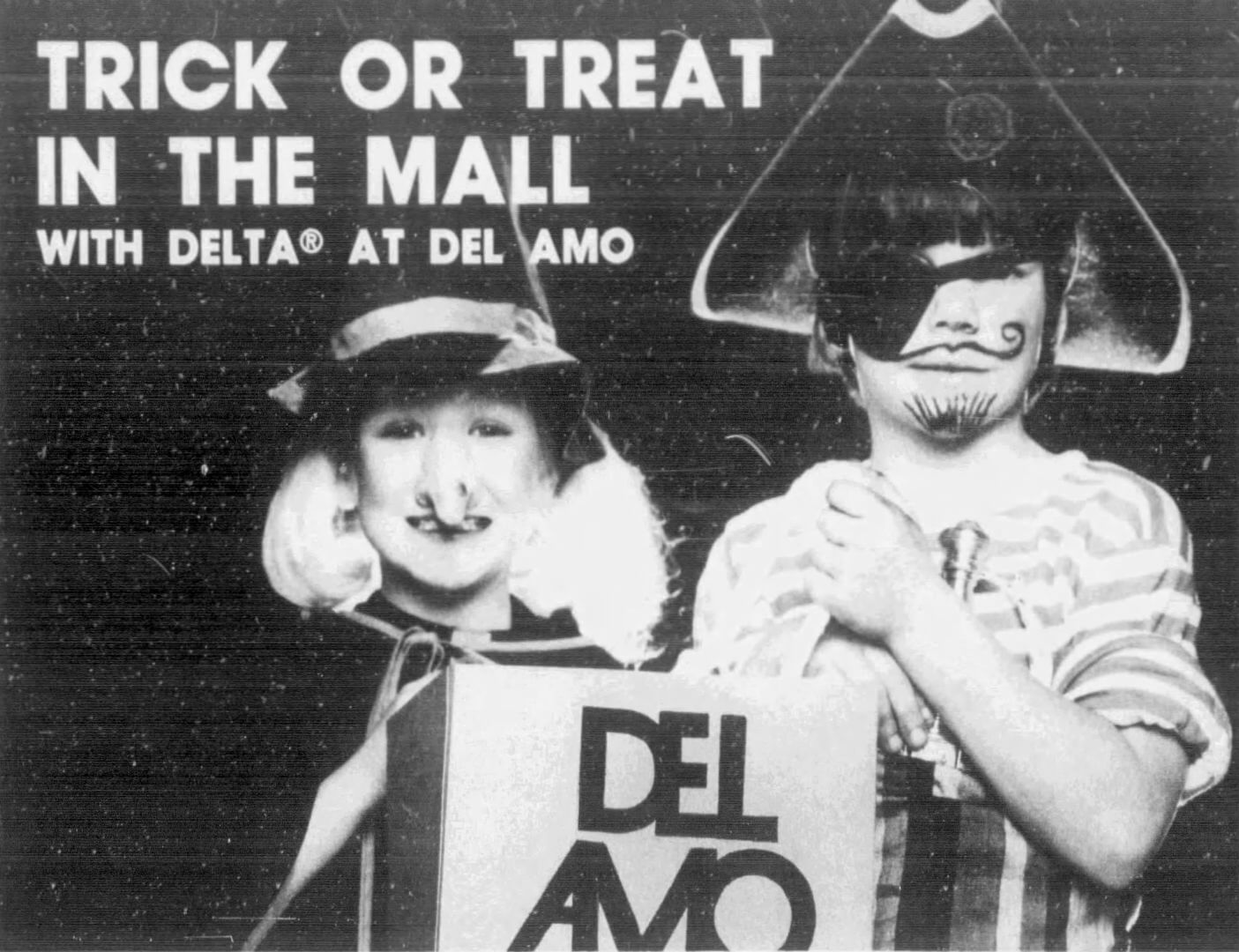
If you go back into the pre-1950s past looking for really really old Halloween stuff, what you’ll find is that those folks back then definitely had something called Halloween, but it is a mere embryo of what it is today. My own research has borne out the fact that our Halloween celebrations are way more modern than we think they are. If Halloween is so old then why did it take until 1978 for somebody to bother to make a movie that capitalizes on the holiday? I mean, there’s a Santa Claus movie from 1889, what was the hold-up?
I mentioned the urban legends of poisoned apples and attempts to ban Halloween above, but that was really a holdover from the pre-1950 history of the holiday, and here’s a smattering of printed descriptions of Halloween ‘celebrations’ from the early 20th century to give you a taste of what I mean. I put no real effort into finding these, which is more an indication of the widespread nature of the sentiment than any confession on the part of your author:
“Chief Scott well remembers the “good old days” when young Monrovia literally wrecked the town on Hallowe’en, keeping the main police force and a lot of the special deputies racing from one end of the city to the other.” – Monrovia, California, 1943
“Trick or Treat incidentally is a juvenile holdup – you “treat” with candy, apples, pennies or what have you to escape the “trick”.” Escabana, Michigan, 1943
“Tricks or Treats differs not in essentials but merely in degree from the gangster’s “stick ‘em up or I’ll shoot.;” – Grand Island, Nebraska, 1940
“Too Busy For Vandalism – Halloween Entertainments are Planned In Many Cities” – Associated Press headline, Halloween 1935
Yes, they had Halloween, but it clearly wasn’t our Halloween – seriously, can you imagine needing to call the police on trick or treaters? Yet by the mid 1950s, you can find grocery stores advertising their specials on “Trick or Treat Candy”. So something shifted post-war and kept shifting, to land us where we are today.

Ideas can come about at any old time, but when you see an idea that goes from “recreational vandalism” to “all-ages favorite” in a flash like Halloween did, we have to ask questions. What about Halloween made it necessary and inevitable, necessary and good in postwar America?
I think the answer is in two interlocked sources: horror movies and suburbia. If you think about it for a moment, Halloween doesn’t make any sense without suburbs. Only the daring children would have formed costumed bands and gone out to soap windows in the cities of the 1920s, but in the suburbs? Relatively low risk. Furthermore, community celebrations like Halloween become even more valuable in the suburbs. The isolating effect of the subdivision is diminished by the sense of community created by a string of decorated homes. Even that road you were warned not to play in becomes a pathway to pleasure. Halloween takes the negatives of the suburbs and turns them into creative positives.

I don’t think it’s overstating the point here to say that Halloween is the most beloved and most specifically North American of the major holidays. Yes, it cannot compare to the year-end holidays in terms of pure earnings potential, but Halloween gets special considerations that the others do not.
For one, it’s open to personalization. You can lean into the horror movie tradition and have zombies and evil clowns climbing over your house, or you can make cardboard tombstones for politicians you dislike and put them on your front lawn. You can dress as Jason Voorhees and scare kids if that’s what you want to do. Nobody’s trying to tell anybody that they’re doing Halloween wrong, because the only way to do it wrong is to not celebrate it. It’s created by and for the pleasure of the general population. In the English-speaking world where we don’t have a formalized Carnival holiday, Halloween has stepped into that role – you can dress up, make fun of authority, and blow off some steam. It’s yours to do with as you please.
And in that larger cultural context, in a culture where we love that season so much that Pumpkin Spice Lattes have become a synonym for American-ness, it’s easy to see why the Haunted Mansion is as beloved as it is. With all of that cultural history tied up in the thing, how could it have been anything less than a classic?
The Haunted Mansion is from a key moment in the creation of a national obsession, situated right there at that intersection of so many strands of popular culture. It opened right between the major phases of the development of the horror film. It’s the home base for a multi-billion dollar industry. And that love of all things creepy and crawly is intimately bound up in the history of the cultural moment from which the attraction hails, a history that’s still unfolding for us now.
I mean, Pirates of the Caribbean reshaped the public perception of piracy to such an extent that today to be a pirate is to come from Disneyland, but the Haunted Mansion is different. The Mansion reflects our own passions back at us, our own folk traditions and celebrations and superstitions and beliefs. We see ourselves, and at the same time, a silly spook sits by our sides. Of course, we love it. Like Halloween itself, it belongs to all of us.
Discount Theme Park Tickets and Travel
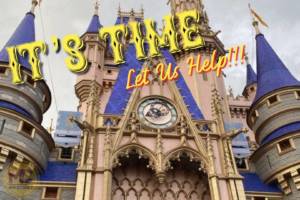 Are you ready to get away? Our travel partners at Get Away Today are here to help you make new family memories with discounted theme park tickets, hotels, and vacation packages. Get extra days, big savings, and perks on travel to Disneyland, Walt Disney World, Disney Cruise Line, Adventures By Disney, and other theme parks and family travel destinations. Snap up those deals while you still can, with your MiceChat partners at Get Away Today- HERE
Are you ready to get away? Our travel partners at Get Away Today are here to help you make new family memories with discounted theme park tickets, hotels, and vacation packages. Get extra days, big savings, and perks on travel to Disneyland, Walt Disney World, Disney Cruise Line, Adventures By Disney, and other theme parks and family travel destinations. Snap up those deals while you still can, with your MiceChat partners at Get Away Today- HERE
(MiceChat has worked with Get Away Today to provide you with the best theme park travel deals and we may make a small commission on any sales made through our links)
More Reading From Foxx Nolte
You can find Foxx’s excellent Haunted Mansion book on Amazon:
Halloween Sources & Resources
-
-
- The Monster Show by David J, Skal
- Halloween: An American Holiday an American History by Leslie Pratt Bannatyne
- Universal Horror by Tom Weaver, John Brunas and Michael Brunas
- Smithsonian: A Brief History of the Haunted House by Chris Heller
- The History of Knott’s Scary Farm / Expedition Theme Park
- Season of Screams (2004) dir. Scott Broad
-


You must be logged in to post a comment.